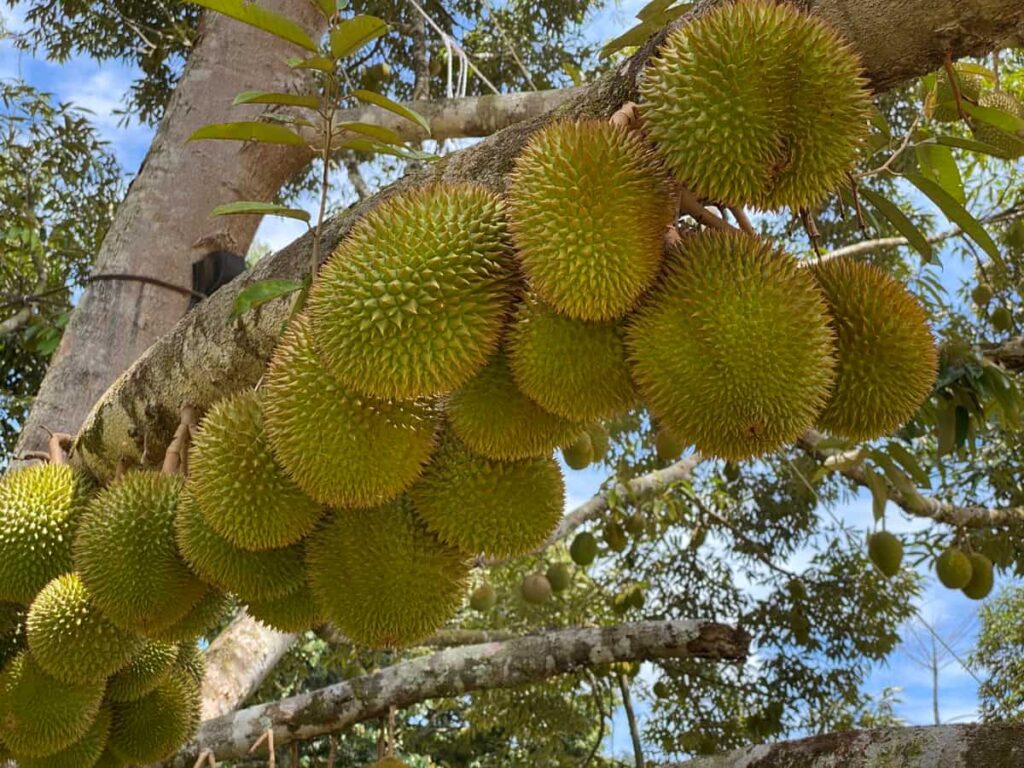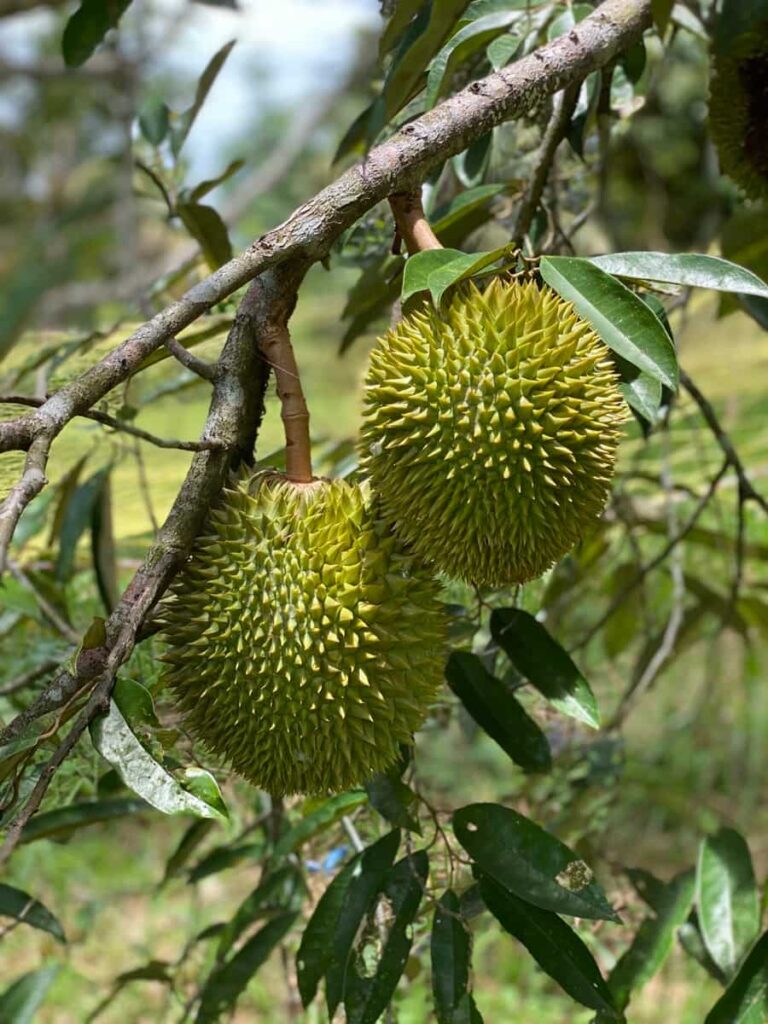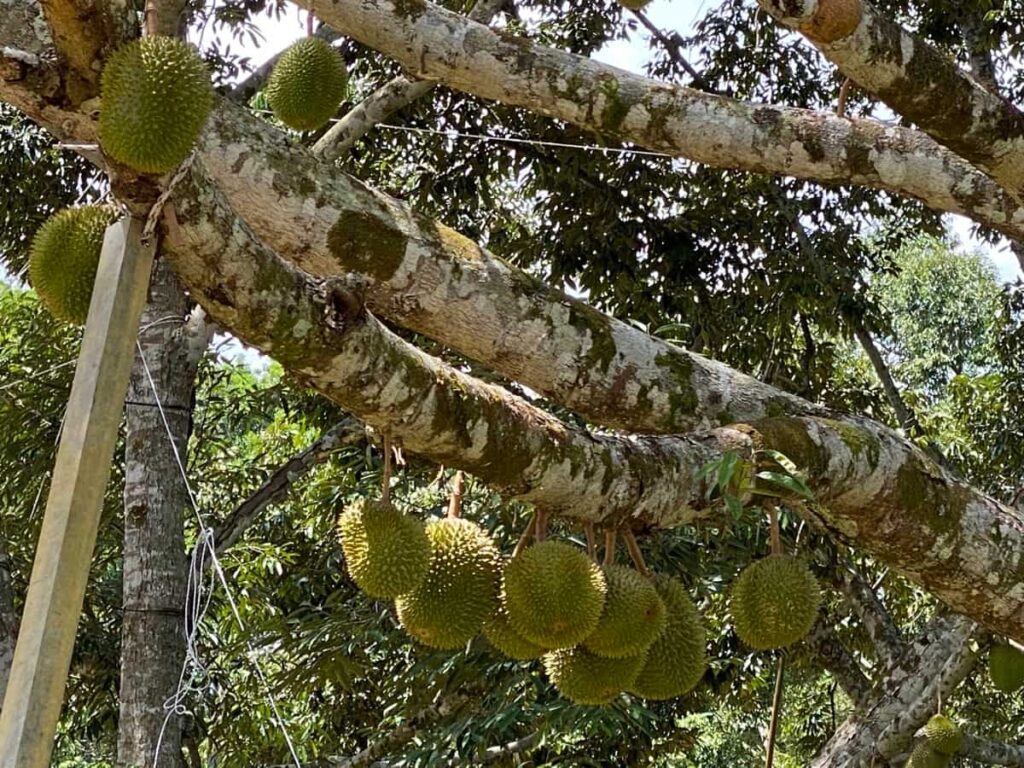Welcome to the aromatic world of Durian fruit farming in the Philippines! Bursting with unique flavors and a distinct smell, Durian has become an increasingly popular tropical fruit worldwide. This blog will take you on a delightful journey through the thriving durian orchards, where you’ll learn about their cultivation, varieties, and the optimal conditions needed for successful farming. With the Philippines being a major exporter of Durian, we’ll delve into the accurate data and statistics that showcase the country’s contribution to this lucrative industry.

What is Durian Fruit Farming?
Durian fruit farming involves cultivating unique and aromatic durian fruit, known for its strong smell and delectable taste. This tropical fruit thrives in the Philippines, Thailand, and Malaysia. Farmers plant durian trees using large-size planting materials (LPM) and select disease-resistant varieties like Musang King and Puyat. Proper management practices, such as regular fertilization, pruning, and pest control, are essential for a successful harvest.
Durian trees typically take four to five years to bear fruit, with full production achieved in around ten years. Once the trees start producing, they can yield impressive quantities of fruits, ranging from 6,000 to 20,000 kilograms per hectare annually. With its growing domestic and international demand, durian fruit farming presents a promising opportunity for small farmers to thrive in the fruit industry.
Benefits of Durian Fruit Farming in the Philippines
- High Demand and Profitability: Durian is known as the “king of fruits” and is highly revered in Southeast Asia. The demand for Durian, both domestically and internationally, is substantial, offering profitable opportunities for farmers.
- Versatile Uses: Durian flesh is consumed fresh, cooked, or boiled with sugar, making it a popular flavoring for ice cream. The fruit is canned, dried, and made into durian paste for export, increasing its value.
- Additional Income from Seeds: Apart from the delectable flesh, the durian seeds are edible too. Farmers can sell boiled, dried, or roasted seeds as snacks, providing an additional source of income.
- Sustainable Farming: With proper management, durian trees can bear fruits for over 50 years, ensuring a sustainable income stream for farmers.
- Potential for Export: The rising demand for Durian in foreign markets, particularly in China, presents an excellent opportunity for Philippine farmers to tap into the export market and increase their income.
- Adaptability: Durian can be grown in various regions within the Philippines, making it accessible to many farmers.
In case you missed it: Growing Jackfruit in the Philipines: A Guide to Varieties, Propagation Methods, and Care

Best Durian Variety for Farming in the Philippines
Selecting the Best Durian Variety for Farming in the Philippines requires factors like: First, choose from four main types: Musang King, D24, XO, and Red Prawn, each with a distinct flavor and texture. Next, assess your farm’s climate and soil conditions. Different durian varieties thrive under specific environments, so select one that can adapt well to your farm’s conditions.
For instance, if your region experiences heavy rainfall, opt for a variety that can handle wet conditions. Market demand is crucial. Ensure a significant demand for the chosen durian type in your area. Popular varieties are more likely to sell well.
Climate Requirements for Successful Durian Cultivation in the Philippines
Specific climate requirements must be met for successful durian cultivation in the Philippines. Durian thrives in lowland tropics at elevations up to 800 meters above sea level. The optimum temperature range is 25-35°C, and a relative humidity of 80% is ideal.
Durian prefers slightly acidic soil with a pH of 5.6 and thrives in sandy loam and clay loam with high organic matter content. Adequate sunlight and well-drained soil are essential for optimal growth. By ensuring these climate conditions are met, durian farmers can create a favorable environment for the fruit to flourish, leading to productive and successful durian cultivation in the Philippines.
Durian Cultivation Techniques in the Philippines
Methods of Propagation
- Durian trees may bear fruit as early as five years in the Philippines.
- In India, they usually bear fruit after 9 to 21 years.
- In Malaya, seedlings bloom in 7 years and grafted trees in 4 years.
- Inarching and patch-budding are used for selected cultivars.
Preparation of Planting Materials
- Use fully developed seeds from mature durian fruits.
- Germinate seeds in a seed box with coco peat, sand, or sawdust.
- Transplant seedlings into PE bags with a soil mixture.
- Water seedlings regularly, ready for grafting at 21-30 days old.
In case you missed it: Optimizing Mango Orchard Operations: A Comprehensive Guide for Month-wise Planning

Cultural Management
- Clear the land and loosen the soil through plowing and harrowing.
- Plant durian trees at 8×8 or 10×10 meters spacing.
- Dig holes 30cm wide and deep for planting.
- Provide temporary shade for young seedlings.
- Apply fertilizer based on soil or plant analysis.
- Intercrop seasonal crops between durian rows before they bear fruit.
- Regularly perform ring weeding and pruning for better air circulation.
- Mulch durian trees during the dry season.
- Water the trees during dry periods; use cut banana pseudostems as mulch in water-scarce areas.
- Hand-pollinate to ensure better fruit setting.
- Thinning is done 4 to 6 weeks after flower opening.
- Use bamboo or wooden poles to prop branches upward for support.
- Harvest Durian when matured, either by waiting for them to fall or picking mature fruits.
- Maturity indices include sound when tapped, light brown pericarp, strong aroma, and distinct sutures.
Durian Farming Practices in the Philippines
- Choose the right location with ample sunlight, well-drained, slightly acidic soil, and good air circulation.
- Plant durian trees during the rainy season to ensure proper establishment.
- Provide each tree with about 10 meters of space for optimal growth.
- Regularly water and fertilize durian trees to support their nutrient needs.
- Protect trees from pests and diseases through early detection and effective control measures.
- Before planting, begin with healthy plants from reputable sources, inspecting them for any signs of pests or diseases.
- Mulch the base around tree to retain moisture and suppress weeds.
- Water durian trees regularly during dry seasons, allowing the topsoil to dry slightly between waterings.
- Apply a balanced fertilizer twice a year, avoiding direct contact with the trunk or leaves.
- Harvest ripe durian fruits between July and August.
- Dry the harvested fruit to preserve its flavor and texture. Drying can occur naturally in the sun or using a dehydrator for two to four weeks.
- Store the properly dried Durian in an airtight container for up to six months.
Durian Tree Care Tips for Philippine Farmers
Durian tree care for Philippine farmers involves selecting a sunny spot with well-drained soil and good air circulation for optimal growth. Choose the rainy season for proper establishment, give each tree 10 meters of space, and water them regularly. Fertilize them twice a year, monitor pests and diseases, use insecticides when needed, mulch around the base, prune to improve air circulation, harvest fruits when they mature, and thin fruits for better quality and higher yield.
Pest and Disease Management in Durian Farms in the Philippines
In durian farming in the Philippines, effective pest and disease management is crucial to ensure healthy and productive trees. Major insect pests affecting durian trees include fruit, shot-hole, durian psyllids, bao-bao, twig borers, and mealy bugs. These pests can cause damage to leaves, shoots, flowers, and fruitlets, leading to decreased fruit yield and even tree death.
- Regular monitoring of fruit borer infestation and fruit thinning to reduce infestation.
- Maintaining tree vigor through fertilization, irrigation, and pruning to deter shot-hole borers.
- Applying insecticides during periods of psyllid infestation to protect young leaves.
- Using the same control measures for bao-bao as for durian psyllids.
- Pruning or cutting damaged branches affected by twig borers and burning them.
- Spraying insecticides during heavy mealybug infestations.
In case you missed it: How to Germinate Seeds: Techniques for Faster Germination of Vegetables, Flowers, Fruits, and Herbs

Regarding diseases, durian trees are susceptible to phytophthora diseases caused by soil-borne fungi. The common types include patch canker, seedling dieback and foliar blight, and phytophthora fruit rot. These diseases can affect all parts of the tree, including the bark, leaves, and fruits, leading to significant damage.
- Provide wide spacing, remove weeds, and prune low-hanging branches to reduce patch canker incidence.
- Apply fungicides at the first sign of infection and remove diseased barks.
- Maintain good sanitation, aeration, and drainage in the nursery to prevent seedling dieback and foliar blight.
- Use systemic fungicides like Metalaxyl or Fosetyl Aluminum for controlling seedling dieback and foliar blight.
- Implement integrated phytosanitary measures, cultural practices, and chemical treatment during the pre-harvest stage to manage Phytophthora fruit rot.
Challenges of Durian Farming in the Philippines
- Climate and Soil: Durians require specific climate conditions and well-drained soil, which may only be readily available in some regions of the Philippines.
- Long Gestation Period: Durian trees take several years to bear fruit, leading to delayed returns on investment for farmers.
- Pests and Diseases: Fruit borers, psyllids, and phytophthora are common challenges affecting durian trees and reducing yields.
- Market Demand: The market for durians can be unpredictable, with fluctuations in demand affecting profitability.
- Labor Intensive: Durian farming involves labor-intensive tasks such as regular pruning and fruit thinning.
- Post-Harvest Handling: Proper post-harvest handling is crucial to maintain fruit quality during transportation and storage.
- Price Fluctuations: Durian prices can vary significantly, impacting farmers’ income and financial stability.
Harvesting and Post-harvest Management of Durian Fruit in the Philippines
Harvesting and post-harvest management are crucial for durian farming. The fruit matures in 106-125 days and falls naturally from the tree when ripe. Hand-picked fruits have a longer shelf life of 5-7 days compared to 2-3 days for fallen fruits. Durians are highly perishable and fully ripen 2-4 days after falling.
Refrigeration at 10-15°C extends their shelf life. Proper post-harvest treatments include sorting fruits by maturity and cultivar, which helps minimize ripening problems. Minimally processed durian pulp can be stored in the freezer for up to six months. Fruits are packed in bamboo baskets, wooden crates, or cartons for local and distant markets, and careful transport and handling are necessary to prevent damage.
Durian Fruit Market Trends in the Philippines
The Philippines’ durian fruit market is experiencing increasing demand due to its unique taste and popularity in various cuisines. The country has seen a significant increase in durian fruit exports to other countries, with value-added products like candies, chips, and ice cream diversifying the market.
Price fluctuations are common, but consumers prefer sustainable farming practices. Improved branding and marketing efforts promote Philippine durian products domestically and internationally. The industry also adopts modern technologies for better storage, transportation, and handling to maintain fruit quality.
Profitability of Durian Farming in the Philippines
Durian farming in the Philippines can be profitable due to the high demand for this unique fruit, especially in Mindanao, known as the ‘durian republic.’ Grafted trees can start producing fruit in as little as 4-6 years, while those grown from seed may take 8-10 years. The top producer of Durian in the country is Calinan District in Davao City.
Proper temperature and soil conditions and organic fertilizer application can help accelerate durian tree growth. Due to its rich taste, Mao Shan Wang is one of the most sought-after and expensive durian varieties. However, durian prices can fluctuate, affecting profitability. Proper storage and selective harvesting can extend the shelf life of Durian and maintain its market value.
In case you missed it: How to Encourage Female Fruit Flowers: Increasing Tips and Techniques

New Opportunities in the Production of Durian: A Success Story
The demand for these fruits matched the production volume, allowing farmers to sell at favorable prices and improve their financial status. This led to a surge in investment, with growers buying quality seedlings to expand their farms. Triple P Farms and Nursery witnessed a skyrocketing demand for planting materials, compelling them to expand their fruit nursery significantly.
Harvesting Durian takes four to five years, and at ten years or beyond, farmers can yield over 20 tons of fruits per hectare annually, generating substantial income for up to 50 years. The rise in the country’s economy played a crucial role in increasing the purchasing power of consumers, resulting in higher fruit consumption. Thanks to President Rodrigo Duterte’s initiatives, improved infrastructure facilitated easier market access for small landholders.
As a result, the entire fruit industry experienced inclusive growth, benefiting all stakeholders involved in this emerging agribusiness opportunity. The future of the fruit industry looks even brighter with soaring demand for Philippine fruits in the export market, especially in China, South Korea, and Europe. Durian’s long shelf-life and new varieties make it suitable for overseas export, triggering a significant increase in demand.
China’s economic growth has spurred a massive demand for Durian, prompting farmers in Thailand and Malaysia to shift their crops to focus on durian production. To capitalize on the export market, Filipino farmers have an opportunity to supply China from August to November, which aligns with the country’s harvest season for Durian, Hongkong, and mangosteen.
Small farmers can earn over a million pesos annually from two hectares of land by adopting modern cultivation techniques and expanding the current durian-growing area. Modernized durian farming involves using large planting materials (LPM) and disease-resistant varieties to achieve high yields of export-quality fruits. Musang King, D197, and Puyat are leading varieties preferred in domestic and foreign markets. Proper management practices, such as adequate fertilization, pruning, and pest control, are crucial for successful durian cultivation.
In case you missed it: Plum Fruit Orchard Management: A Comprehensive Month-wise Maintenance Guide

Conclusion
Durian fruit farming in the Philippines offers great potential for farmers, especially in Mindanao. With proper care and management, durian trees can bear fruit in as early as 4-6 years. Adequate post-harvest handling is vital to ensure the marketability of this highly perishable fruit.
- Broccoli Varieties: Choosing the Right Cultivars for Your Farm
- How to Raise Pigs in Your Own Backyard: A Comprehensive Guide
- Budget Friendly Sheep Shed Ideas: Cheap and Low-Cost Tips
- How Much Do Cattle Farmers Make: Revenue Streams in Cattle Farming
- Management Pests and Diseases in Your Cotton Field
- Sheep Farming Business Plan for Beginners
- Aquaponic Farming at Home: A Step-By-Step Guide
- Profitable Village Farming Business Ideas in 2024
- High-Yield Aquaculture: Fast-Growing Fish for Farming
- Effective Fish Pond Construction Techniques for Beginners
- Irrigation and Water Management in Pineapple Farming
- Blossom to Harvest: Mastering Flowering and Pollination in Papaya Farming
- Pig Fattening Essentials: From Selection to Sale for Beginners
- Raising Wagyu Cattle: A Complete Guide for Premium Beef Production
- Soil Types and Their Water Holding Capacity
- Optimizing Irrigation Schedules for Coconut Groves for Enhanced Yield
- Espresso Your Garden: Coffee Grounds for Healthier Acid-Loving Plants
- The Best Soil Mix for Snake Plants: How to Mix Your Own Snake Plant Soil
- Green Thumb Success: Expert Tips for Cultivating Greenhouse Beans All Year Round
- Bloom All Year Round: The Ultimate Guide to Indoor Hyacinth Care
- Eco-Friendly Gardening: How to Make Liquid Fertilizer from Kitchen Waste
- Ultimate Guide to Grow Anise in Pots: Explore Seed Propagation to Harvesting
- Guide to Raising Chester White Pigs: Discover Breed Facts to Growth Management
- Mastering the Elegance: The Ultimate Guide to Weeping Cherry Tree Care, Planting, and Maintenance
- Ultimate Guide to Planting Garlic in Grow Bags: Growing Strategies for Beginners
- How to Fix Spider Plant Leaf-Related Problems: Natural and Organic Remedies
- 10 Reasons Why Your Tulsi Plant is Shedding Leaves: Home Remedies and Solutions
- Optimizing Growth and Yield: The Advantages of Palm Bunch Ash Fertilizer
- Utilizing Neem Oil Extract as a Natural Pesticide for Hydrangea
- From Soil to Harvest: Various Ways in Which Farmers Can Use AI Tools
- Steps to Encourage and Induce Citrus Flowers: A Comprehensive Guide
- How to Fix Snake Plant Leaf-Related Issues: Natural and Organic Remedies
- Transform Your Garden into a Fragrant Oasis with Raat Ki Rani (Night Blooming Jasmine)
- Discover the Ideal Chicken Breeds for Philippine Farms
- How to Create a Poultry Egg Farm Business Plan for Profits
- Grow Lemon Cucumbers Like a Pro: Insider Techniques for Bountiful Yields
